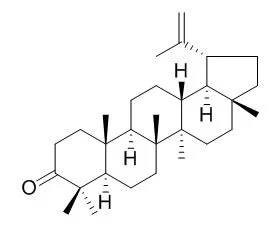| Description: |
Lupenone and lupeol inhibit protein tyrosine phosphatase 1B (PTP1B) with IC50 values of 13.7 ± 2.1 and 5.6 ± 0.9 uM, respectively, they are non−competitive inhibitors of PTP1B, and PTP1B appears to be an attractive target for the development of new drugs for type 2 diabetes and obesity. Lupenone stimulates melanogenesis by increasing the tyrosinase enzyme expression via mitogen-activated protein kinase phosphorylated extracellular signal-regulated kinases 1 and 2 phosphorylation inhibition. A 1 : 4 mixture of Lupenone and caryophyllene oxide shows trypanocidal activity. |
| Targets: |
PPAR | ERK | MAPK | Antifection | PTP1B |
| In vitro: |
| Phytother Res. 2013 May;27(5):761-6. | | Lupenone isolated from Adenophora triphylla var. japonica extract inhibits adipogenic differentiation through the downregulation of PPARγ in 3T3-L1 cells.[Pubmed: 22848028] | Adenophora triphylla var. japonica (Campanulaceae) is known to have anti-inflammatory and anti-tussive effects. Dysfunction of adipocytes and adipose tissue in obesity is related to various inflammatory cytokines or adipokines.
METHODS AND RESULTS:
In this study, we investigated whether Lupenone isolated from A. triphylla var. japonica extract inhibits adipocyte differentiation and expression of adipogenic marker genes in 3T3-L1 preadipocytes. We demonstrated that Lupenone resulted in a significant reduction in lipid accumulation and expression of adipogenic marker genes in a dose-dependent manner. In addition, Lupenone decreased the transcriptional activity of peroxisome proliferator-activated receptor γ (PPARγ) induced by troglitazone, and we also demonstrated that Lupenone suppressed the PPARγ and CCAAT-enhancer-binding protein α (C/EBPα) protein levels.
CONCLUSIONS:
These findings demonstrated that Lupenone isolated from A. triphylla var. japonica extract effectively inhibited adipocyte differentiation through downregulation of related transcription factor, particularly the PPARγ gene. | | Evid Based Complement Alternat Med. 2013;2013:435398. | | Synergistic Effect of Lupenone and Caryophyllene Oxide against Trypanosoma cruzi.[Pubmed: 23762135] | | The in vitro trypanocidal activity of a 1 : 4 mixture of Lupenone and caryophyllene oxide confirmed a synergistic effect of the terpenoids against epimastigotes forms of T. cruzi (IC50 = 10.4 μ g/mL, FIC = 0.46). In addition, testing of the terpenoid mixture for its capacity to reduce the number of amastigote nests in cardiac tissue and skeletal muscle of infected mice showed a reduction of more than 80% at a dose level of 20.8 mg·kg(-1)·day(-1). | | Biomed Pharmacother . 2018 Jul;103:198-203. | | Beneficial health effects of lupenone triterpene: A review[Pubmed: 29653365] | | Abstract
There are a large number of new structure compounds with good pharmacological activity in the natural plants, can be applied to the treatment of human diseases. Finding active ingredients from the plants is one of the important ways to develop new drugs. Triterpenes are widespread in plants, and Lupenone belongs to lupane type triterpenoids. Lupenone is very common natural ingredient distributed in multi-family plants including Asteraceae, Balanophoraceae, Cactaceae, Iridaceae, Musaceae, Urticaceae, Leguminosae, Bombacaceae, etc., but its distribution has no regular. The consumption of Lupenone in vegetarian diet is high in human life. Pharmacological screening of Lupenone revealed various pharmacological activities including anti-inflammatory, anti-virus, anti-diabetes, anti-cancer, improving Chagas disease without major toxicity. Based on these important pharmacological activities, this review provides detailed account of pre-clinical studies conducted to determine the utility of Lupenone as a therapeutic and chemopreventive agent for the treatment of various diseases.
Keywords: Chagas disease; Diabetes; Inflammation; Lupenone; Tumor; Virus. |
|
| In vivo: |
| Mol Divers . 2020 Feb;24(1):21-30. | | Lupenone is a good anti-inflammatory compound based on the network pharmacology[Pubmed: 30796639] | | Abstract
The dried rhizome of Musa basjoo Sieb. et Zucc. is Rhizoma Musae. It has been used to treat diabetes in Miao medicine in China. Lupenone was isolated from Rhizoma Musae and has good anti-diabetic activity. Its mechanism of action is unclear. Diabetes is a chronic low-level systemic inflammatory disease, and Lupenone has anti-inflammatory activity, but the underlying mechanism is not fully elucidated. In this study, we aimed to construct the drug-target biologic network and predict the anti-inflammatory mechanism of Lupenone. The network-based pharmacologic analysis platform was used to identify the target proteins related to inflammation. Furthermore, the effects of Lupenone on acute, subacute and diabetic pancreatic inflammation were evaluated. The "component-target-disease" network was constructed using Cytoscape. Lupenone could regulate transcription factor p65, NF-kappa-B inhibitor alpha, transcription factor AP-1, NF-kappa-B essential modulator, nuclear factor NF-kappa-B p105 subunit, epidermal growth factor receptor, hypoxia-inducible factor 1-alpha and other proteins related to the PI3K-Akt, Toll-like receptor and NF-kappa B signaling pathways. In addition, Lupenone significantly decreased acute and subacute inflammation in mice as well as the IL-1β and IFN-γ levels in the pancreas of diabetic rats. The above results provide strong support for studying the molecular mechanism of Lupenone in the treatment of diabetes from the perspective of anti-inflammation.
Keywords: Diabetes; Inflammation; Lupenone; Network pharmacology; Pancreas; Target. |
|






 Cell. 2018 Jan 11;172(1-2):249-261.e12. doi: 10.1016/j.cell.2017.12.019.IF=36.216(2019)
Cell. 2018 Jan 11;172(1-2):249-261.e12. doi: 10.1016/j.cell.2017.12.019.IF=36.216(2019) Cell Metab. 2020 Mar 3;31(3):534-548.e5. doi: 10.1016/j.cmet.2020.01.002.IF=22.415(2019)
Cell Metab. 2020 Mar 3;31(3):534-548.e5. doi: 10.1016/j.cmet.2020.01.002.IF=22.415(2019) Mol Cell. 2017 Nov 16;68(4):673-685.e6. doi: 10.1016/j.molcel.2017.10.022.IF=14.548(2019)
Mol Cell. 2017 Nov 16;68(4):673-685.e6. doi: 10.1016/j.molcel.2017.10.022.IF=14.548(2019)